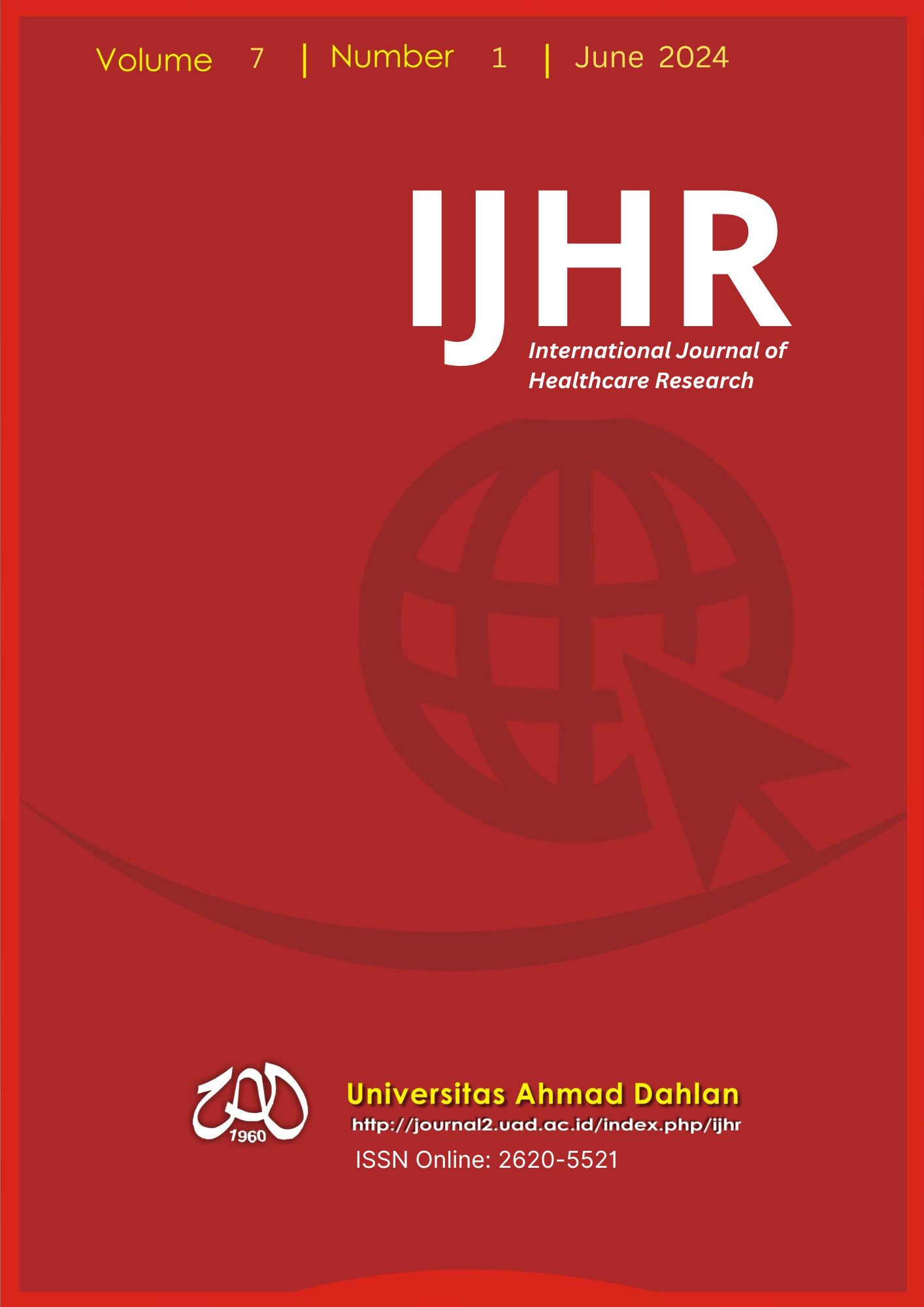Analysis of Customer Needs in the House of Quality to Improve the Quality of Inpatient Room Services at Hospital X in Yogyakarta
DOI:
https://doi.org/10.12928/ijhr.v7i1.11324Abstract
Background: House of Quality is a matrix that is widely used to achieve higher customer satisfaction. Hospital X in Yogyakarta City is one of the Private Hospitals type B, The number of unstable patient visits each year and the presence of various patient complaints may be caused by several factors that influence patient perceptions in choosing health services in inpatient installations. The purpose of this study was to analyze Customer Need in the House of Quality (HOQ) in improving the quality of service in the Inpatient Installation of Hospital X in Yogyakarta City.
Methods: This study uses a qualitative method with a phenomenology design type. The method of selecting subjects uses a purposive sampling method with the consideration of researchers, namely, patients from the VIP sakinah ward of Hospital X in Yogyakarta City with details, 3 key informants with a minimum of 2 days of care. While the triangulation informants are 3 people. with details, 1 Ward Officer, 1 Service Quality Committee Officer, 1 Public Relations and Marketing Officer.
Results: Based on the results of the analysis of 5 dimensions, tangibles, reliability, responsiveness, assurance and empathy. Each patient gives their own perception and expectations, there is one dimension of service quality that patients consider less good, namely the empathy dimension. In the empathy dimension, patients feel that officers have not fully paid attention to patients.
Conclusion: there is one dimension of service quality that patients consider less good, namely the empathy dimension, as a quality improvement strategy, hospitals can conduct excellent service training.
References
A. W. Wicaksono, “Penerapan Metode QFD Pada Rencana Pengembangan Sekolah Di SMKN 2 Yogyakarta,” skripso S1 Fak. Tek. Univ. Negeri Yogyakarta, p. 185, 2013.
E. S. M.Imron Rosyidi, I wayan Sudarta, Manajemen Mutu Pelayanan Kesehatan. Yogyakarta: Gosyen Publishing, 2020.
W. and F. T. The Health and Social Care Information Centre, “Data on Written Complaints in the NHS 2011-12,” no. August, pp. 1–81, 2012.
A. Anhari and H. Setyono, “Analisis Sikap Konsumen Pada Rumah Sakit Umum,” Univ. Ahmad Dahlan, pp. 44–55, 2019.
M. E. P. Prof. Dr.Sugiono, Metode Penelitian Kesehatan, Pertama. Bandung: Aflabeta, 2020.
Hendrisman, S. Sutomo, Arnawilis, B. Hartono, and Lita, “Analisis Manajemen Pemeliharaan Sarana dan Prasarana di Rumah Sakit Umum Daerah Rokan Hulu,” J. Kesehat. Komunitas, vol. 7, no. April, pp. 45–56, 2021.
Depkes RI, “Pedoman Teknis Sarana Dan Prasarana Rumah Sakit Kelas C,” pp. 1–95, 2007.
C. Lee, S. M., Lee, D., & Kang, “The impact of service quality on customer satisfaction and loyalty: Moderating effects of identify visibility,” J. Retail. Consum. Serv., vol. 61, 2021.
C. S. Goh, M. L., Low, L. L., & Tan, “Enhancing hospital service reliability through human resource management: An empirical investigation,” J. Serv. Theory Pract., vol. 35, no. 5, pp. 689–709, 2021.
M. H. Nguyen, T. H., Nguyen, N. T., & Le, “he impact of service quality on patient satisfaction and loyalty in public hospitals: Evidence from Vietnam,” BMC Health Serv. Res., vol. 22, no. 1, p. 206, 2022.
S. Jain, R., Aagja, J. P., & Bagdare, “Measuring service quality in healthcare: An integrated approach using SERVQUAL and QFD,” Int. J. Health Care Qual. Assur., vol. 34, no. 2, pp. 106–125, 2021.
Kementerian Kesehatan RI, Permenkes Nomor 4 Tahun 2018. 2018.
Z. Z. Rahman, S., Zainal, A., & Ariffin, “Responsiveness in healthcare: A crucial factor in patient satisfaction and loyalty in Malaysian public hospitals,” J. Healthc. Manag., vol. 67, no. 2, pp. 142–154, 2022.
S. Y. Kim, J. H., & Kim, “Impact of healthcare workers’ responsiveness on patient satisfaction in emergency departments,” Int. J. Environ. Res. Public Health, vol. 20, no. 3, p. 1559, 2023.
I. A. T. dan D. Lena, Manajemen Mutu Informasi Kesehatan I:Quality Assurance, Pertama. Pusat Pendidikan Sumber Daya Manusia Kesehatan (KEMENKES) Badan Pngembangan dan Pemberdayaan Sumber Daya Manusia Kesehatan Edisi 2017, 2017.
R. Indonesia, “Undang - Undang Republik Indonesia Nomor 44 Tahun 2009 Tentang Rumah Sakit,” Undang Undang RI, vol. 2, no. 5, p. 255, 2009.
G. S. Juwita, L. Marlinae, and F. Rahman, “Hubungan Mutu Pelayanan Dengan Kepuasan Pasien Rawat Inap Di Rumah Sakit Umum Daerah Tamiang Layang,” J. Publ. Kesehat. Masy. Indones., vol. 4, no. 2, pp. 49–56, 2017, doi: 10.20527/jpkmi.v4i2.3841.
M. Sujarwo and S. Subekti, “Membangun Quality Function Deployment Untuk Meningkatkan Kepuasan Pasien Pada Rumah Sakit Di Kota Tegal,” Benefit J. Manaj. dan Bisnis, vol. 3, no. 1, p. 74, 2018, doi: 10.23917/benefit.v3i1.6741.
Haerawati Idris ; Intan Gayatri, Monograf Penilaian Mutu Pelayanan Kesehatan di Rumah Sakit: Pendekatan Quality Function Deployment. 2021.
A. Prabhu, S., Rao, S., & Shetty, “Enhancing patient satisfaction through effective communication and responsiveness in healthcare services,” J. Patient Exp., vol. 9, 2022.
R. Chaudhary, S., Bhardwaj, A., & Gupta, “Patient satisfaction and perceived quality of health care services: Evidence from Indian hospitals,” ournal Heal. Manag., vol. 24, no. 3, pp. 275–290, 2022.
S. Kaur, P., Gupta, M., & Singh, “The impact of service quality on patient satisfaction and loyalty in hospitals,” Int. J. Health Care Qual. Assur., vol. 36, no. 1, pp. 46–63, 2023.
Downloads
Published
Issue
Section
License
Copyright (c) 2024 Rokhmayanti Rokhmayanti, Siti Kurnia Widi Hasuti, Fardhiasih Dwi Astuti

This work is licensed under a Creative Commons Attribution-ShareAlike 4.0 International License.
Authors who publish with IJHR agree to the following terms:
- Authors retain copyright and grant the journal right of first publication with the work simultaneously licensed under a Creative Commons Attribution License (CC BY-SA 4.0) that allows others to share the work with an acknowledgment of the work's authorship and initial publication in this journal.
- Authors are able to enter into separate, additional contractual arrangements for the non-exclusive distribution of the journal's published version of the work (e.g., post it to an institutional repository or publish it in a book), with an acknowledgment of its initial publication in this journal.
- Authors are permitted and encouraged to post their work online (e.g., in institutional repositories or on their website) prior to and during the submission process, as it can lead to productive exchanges, as well as earlier and greater citation of published work.

This work is licensed under a Creative Commons Attribution-ShareAlike 4.0 International License.




